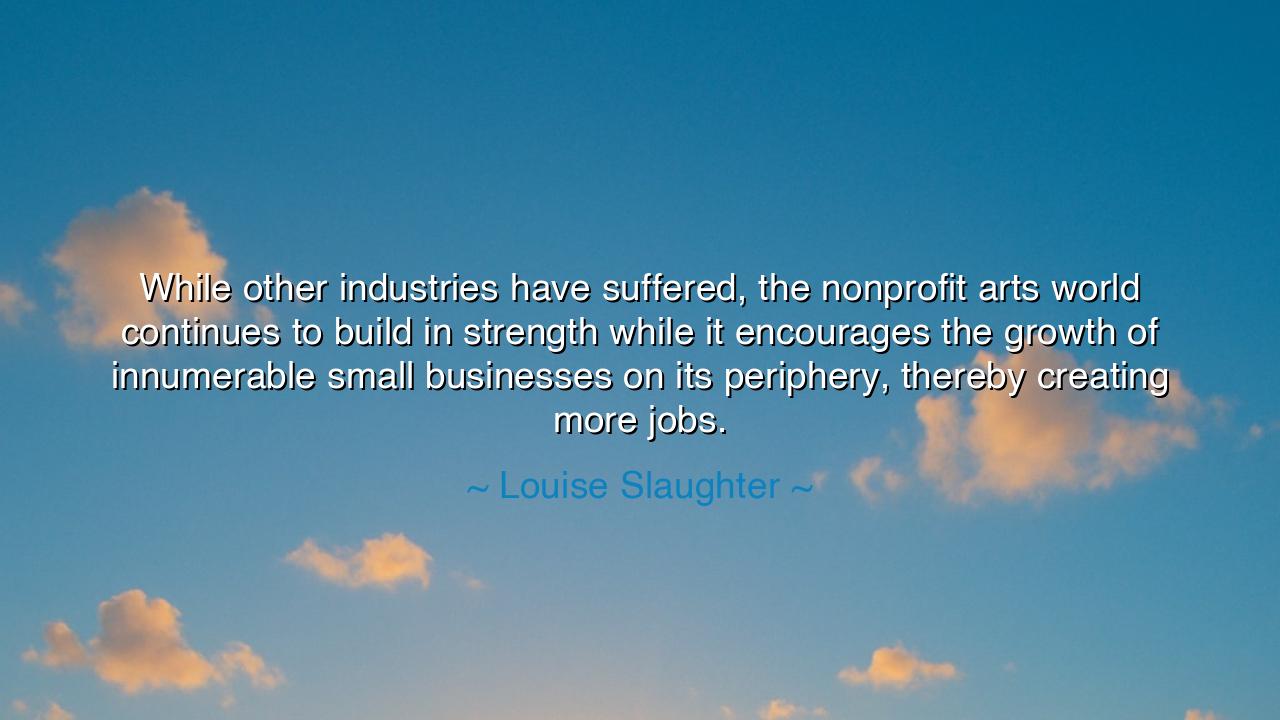
While other industries have suffered, the nonprofit arts world
While other industries have suffered, the nonprofit arts world continues to build in strength while it encourages the growth of innumerable small businesses on its periphery, thereby creating more jobs.






"While other industries have suffered, the nonprofit arts world continues to build in strength while it encourages the growth of innumerable small businesses on its periphery, thereby creating more jobs." These are the words of Louise Slaughter, the congresswoman and advocate for the arts, whose voice carried both conviction and vision. Her statement is not simply about the economy—it is about the resilience of the human spirit, the enduring power of creativity, and the unseen ways in which art nourishes not only the soul, but also the marketplace.
The ancients knew that art was not a luxury but a foundation of civilization. The poets of Greece, the dramatists of Rome, the musicians of every culture—these were not merely entertainers but builders of identity, carriers of truth, and sources of unity. Slaughter’s words remind us that even when other pillars of society tremble, the nonprofit arts world endures, not because it yields the greatest profit, but because it springs from the deepest well of human need: the need to create, to tell stories, to give meaning to existence.
And yet, Slaughter’s wisdom goes further. She reveals that the arts, though often seen as intangible, have material strength. Around the great theaters, galleries, and music halls rise small businesses—cafés, bookshops, instrument makers, costume designers, printers, and countless others who find life in the shadow of the arts. Thus, the arts are not separate from the economy; they are a silent engine that creates jobs, sustains families, and strengthens communities. What seems fragile—the play, the painting, the dance—proves stronger than industries that measure themselves only in profit.
History bears witness. Consider the story of the Florentine Renaissance, when patronage of the arts did not only give birth to Michelangelo and Leonardo, but also to a thriving network of apprentices, craftsmen, builders, and merchants. The investment in art created ripples that lifted all of Florence, enriching both culture and economy. So too in Slaughter’s vision: the nonprofit arts world, though not driven by wealth, multiplies wealth by nurturing those who serve alongside it.
But there is also something heroic in the endurance of art during times of suffering. When economies falter, factories close, and industries weaken, the arts remain as a flame that refuses to die. During the Great Depression, the United States saw the Federal Art Project employ thousands of painters, actors, and writers, who gave the nation not only wages, but also hope. While industries crumbled, murals rose, plays were performed, and music was heard in the streets. It was proof that while man needs bread to live, he also needs meaning—and the arts provide both.
The lesson is clear: we must never dismiss the arts as mere decoration. They are both anchor and engine, sustaining the human spirit while fostering tangible growth in the world of labor and commerce. They feed not only the imagination but the marketplace. When we invest in art, we invest not only in beauty, but in strength—strength that radiates outward into communities, families, and future generations.
Practically, this means supporting the nonprofit arts in your own life and community. Attend performances, visit galleries, contribute to local organizations, and encourage others to do the same. Recognize that every ticket bought, every donation given, every moment spent in support of art nourishes not only the artist but the network of businesses and workers around them. By doing so, you become part of the quiet revolution that Slaughter described—a movement that builds resilience, creates jobs, and strengthens the very fabric of society.
So let these words be remembered: “The nonprofit arts world continues to build in strength.” Pass them down to your children as proof that even in times of suffering, the arts endure and uplift. Teach them that when nations support their artists, they do not only preserve beauty—they preserve the resilience of the human spirit and the prosperity of their people. For in the flourishing of art, both soul and society find their renewal.






AAdministratorAdministrator
Welcome, honored guests. Please leave a comment, we will respond soon